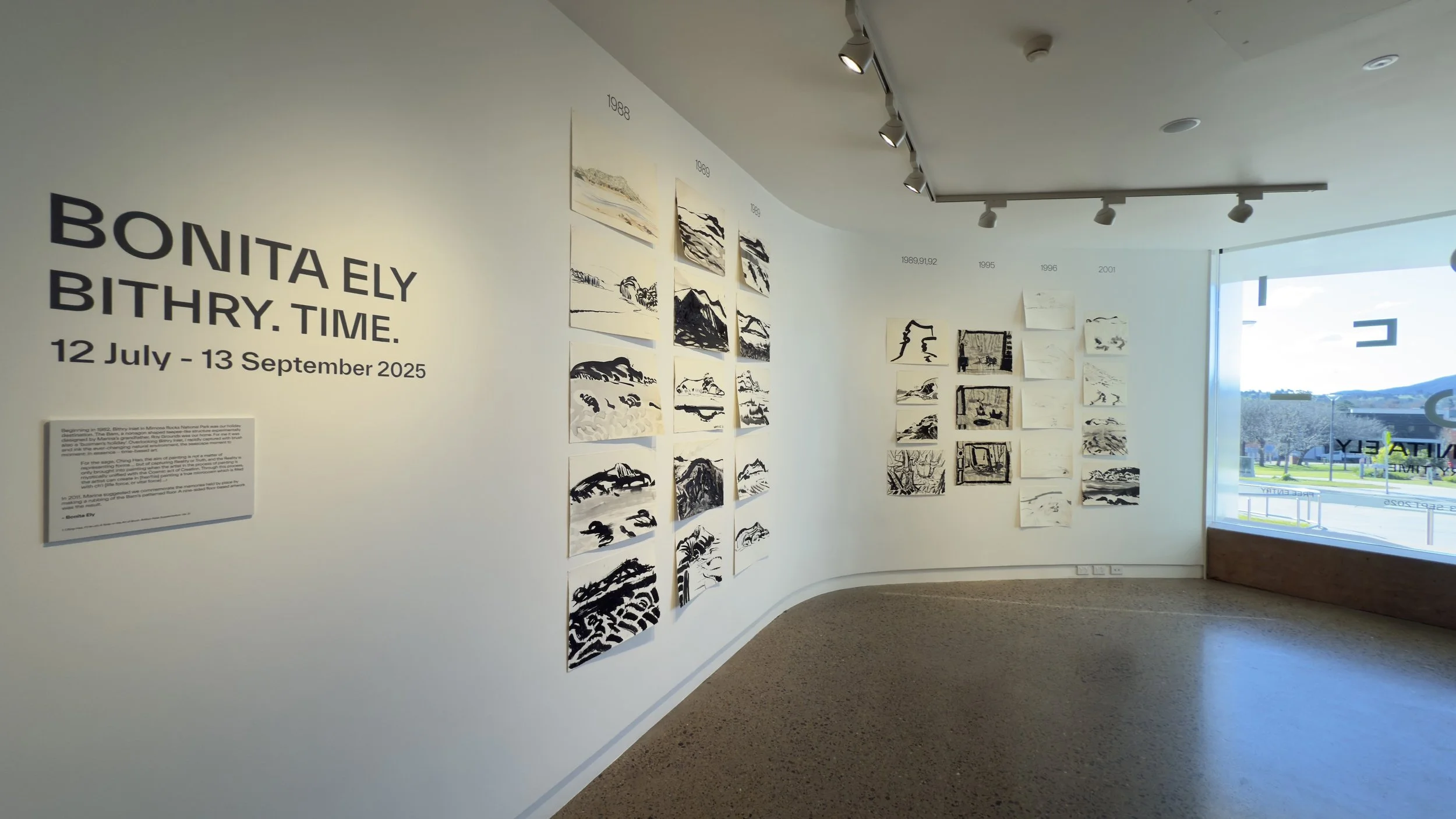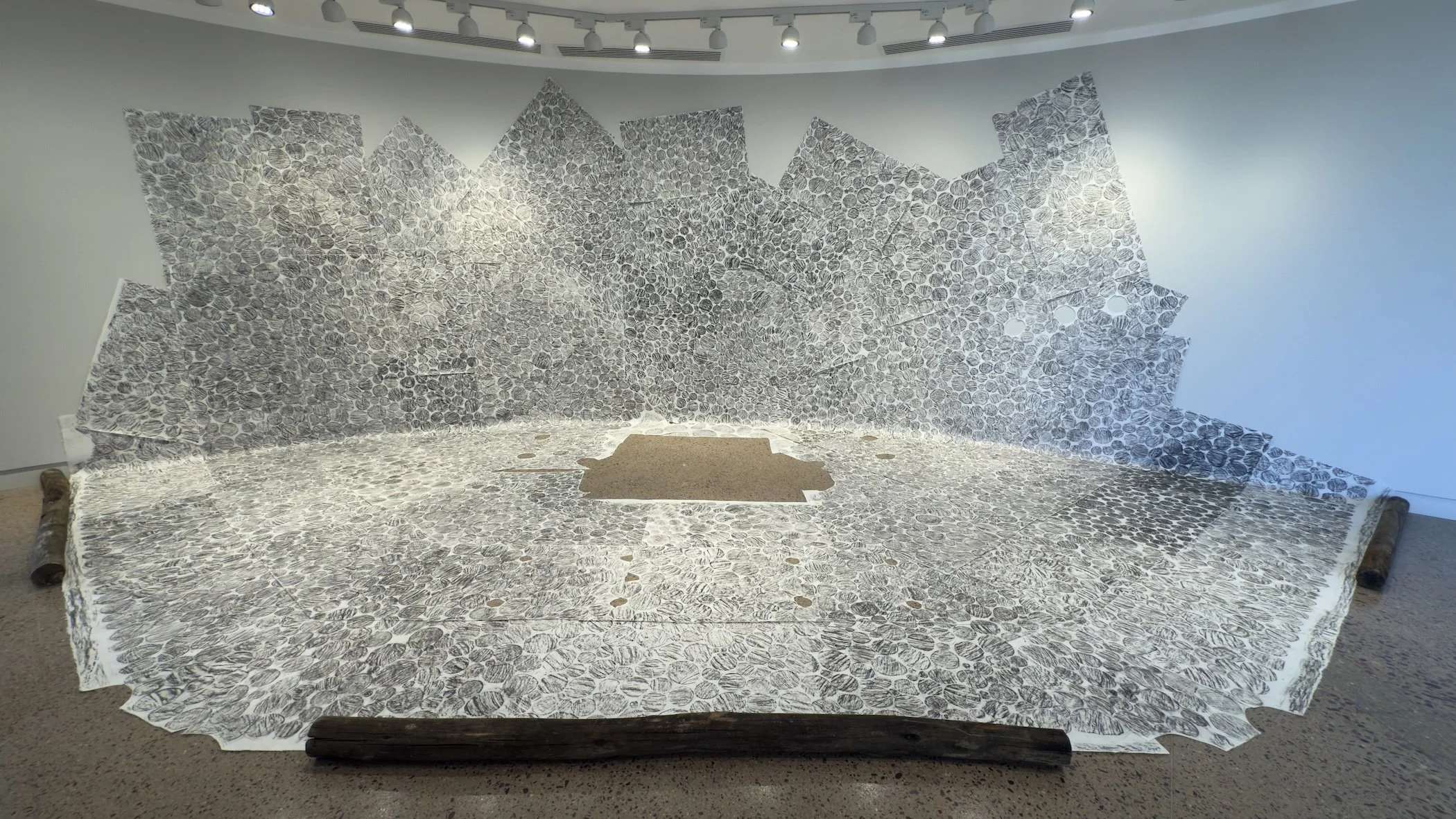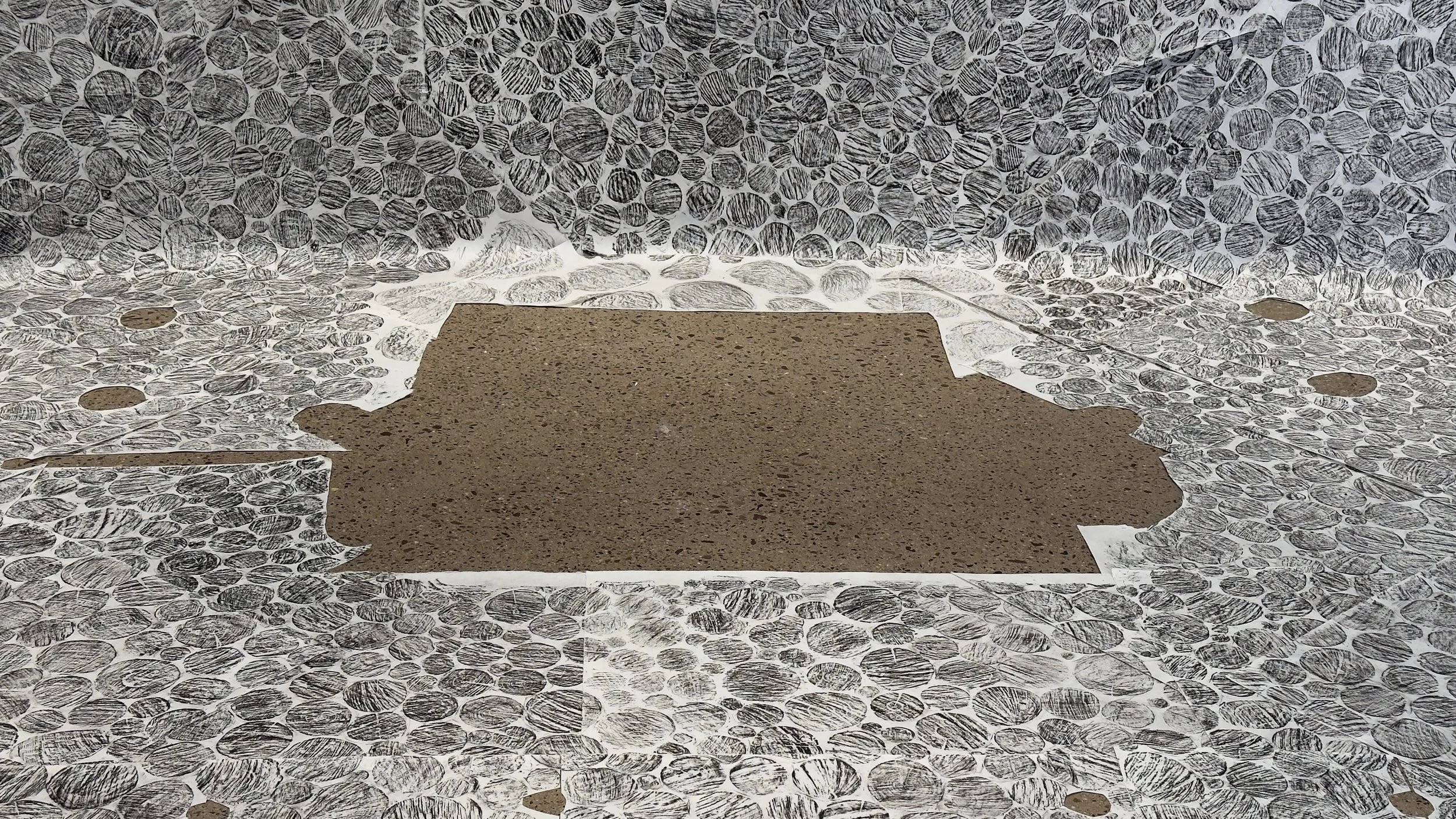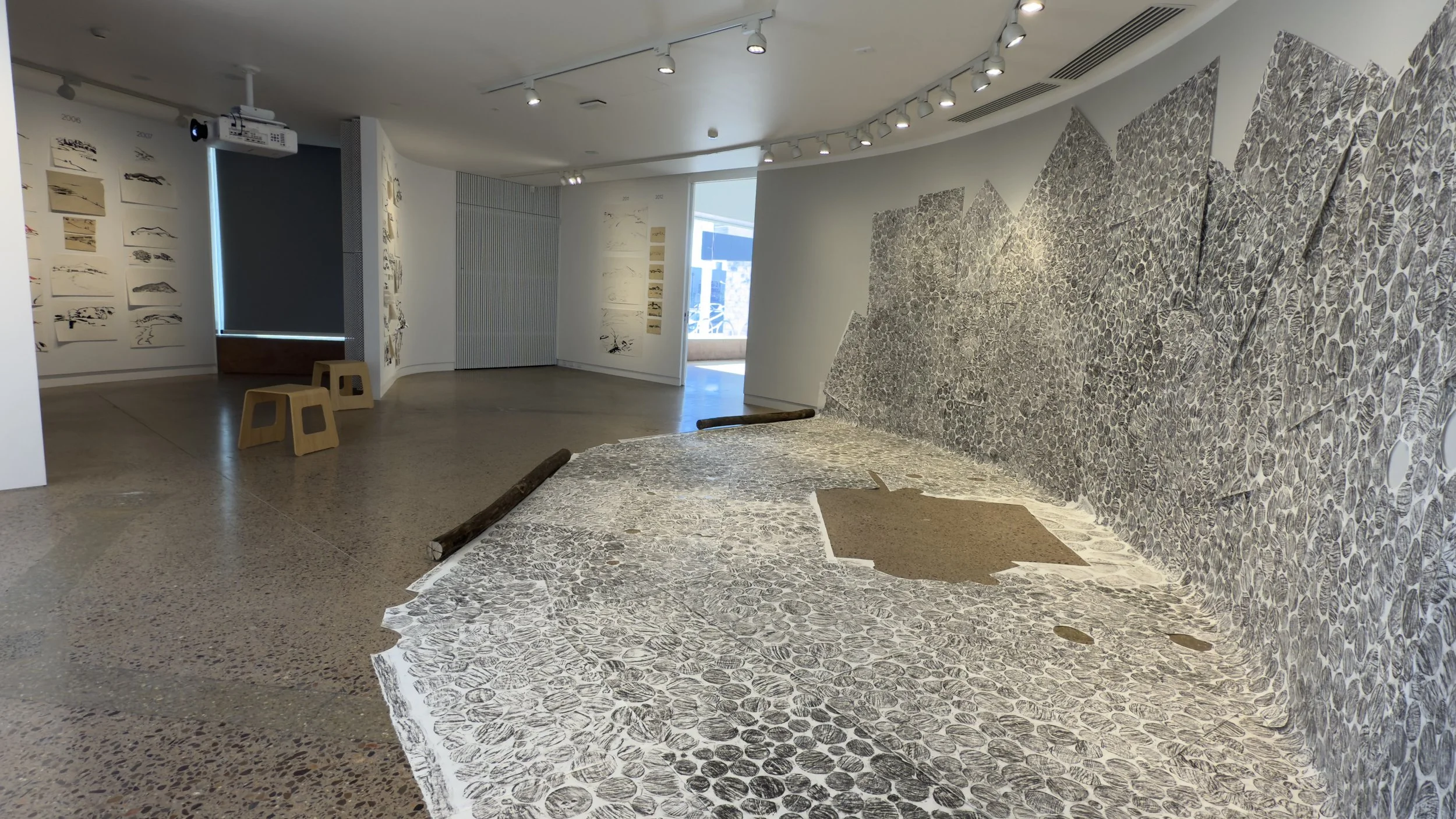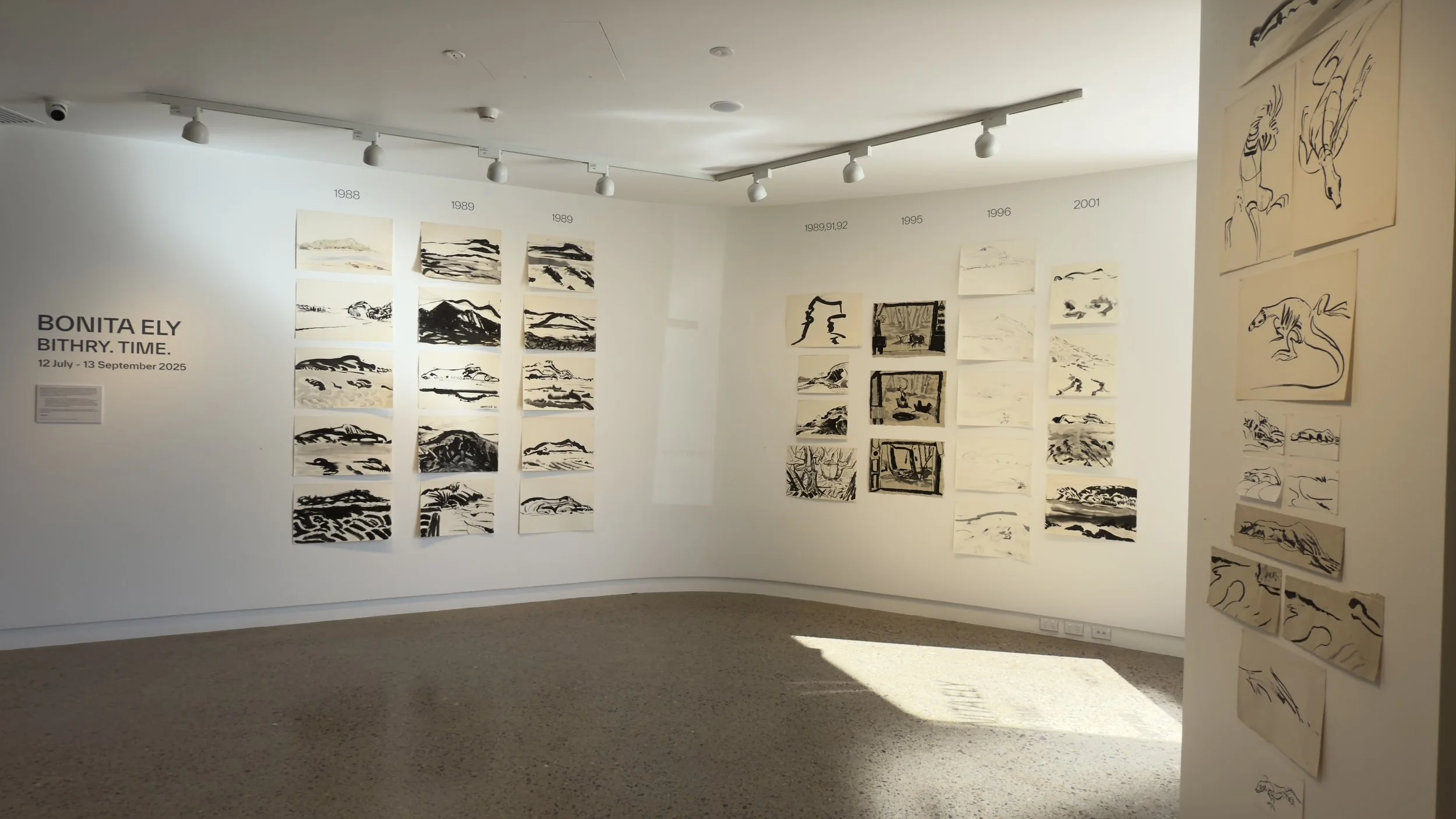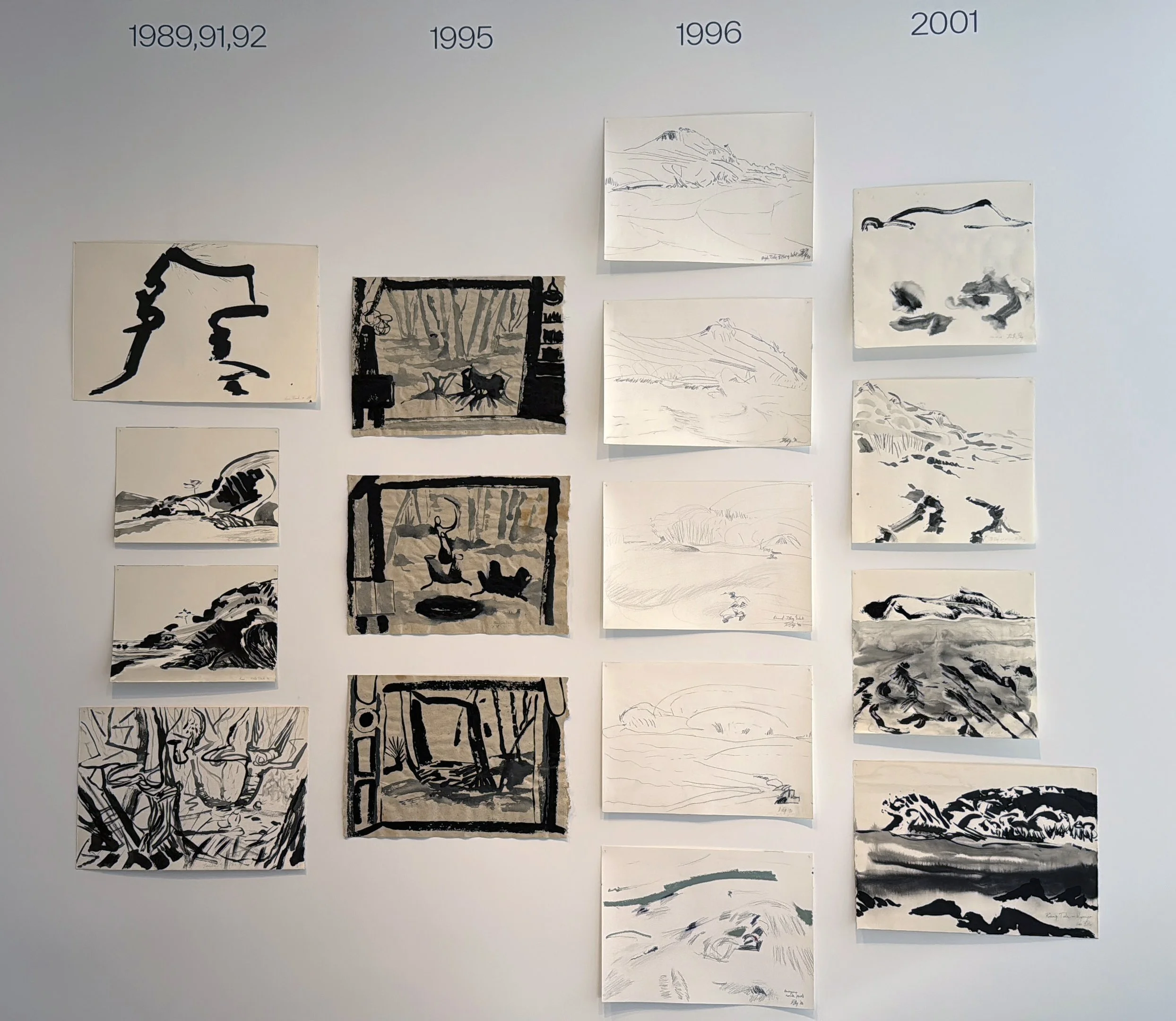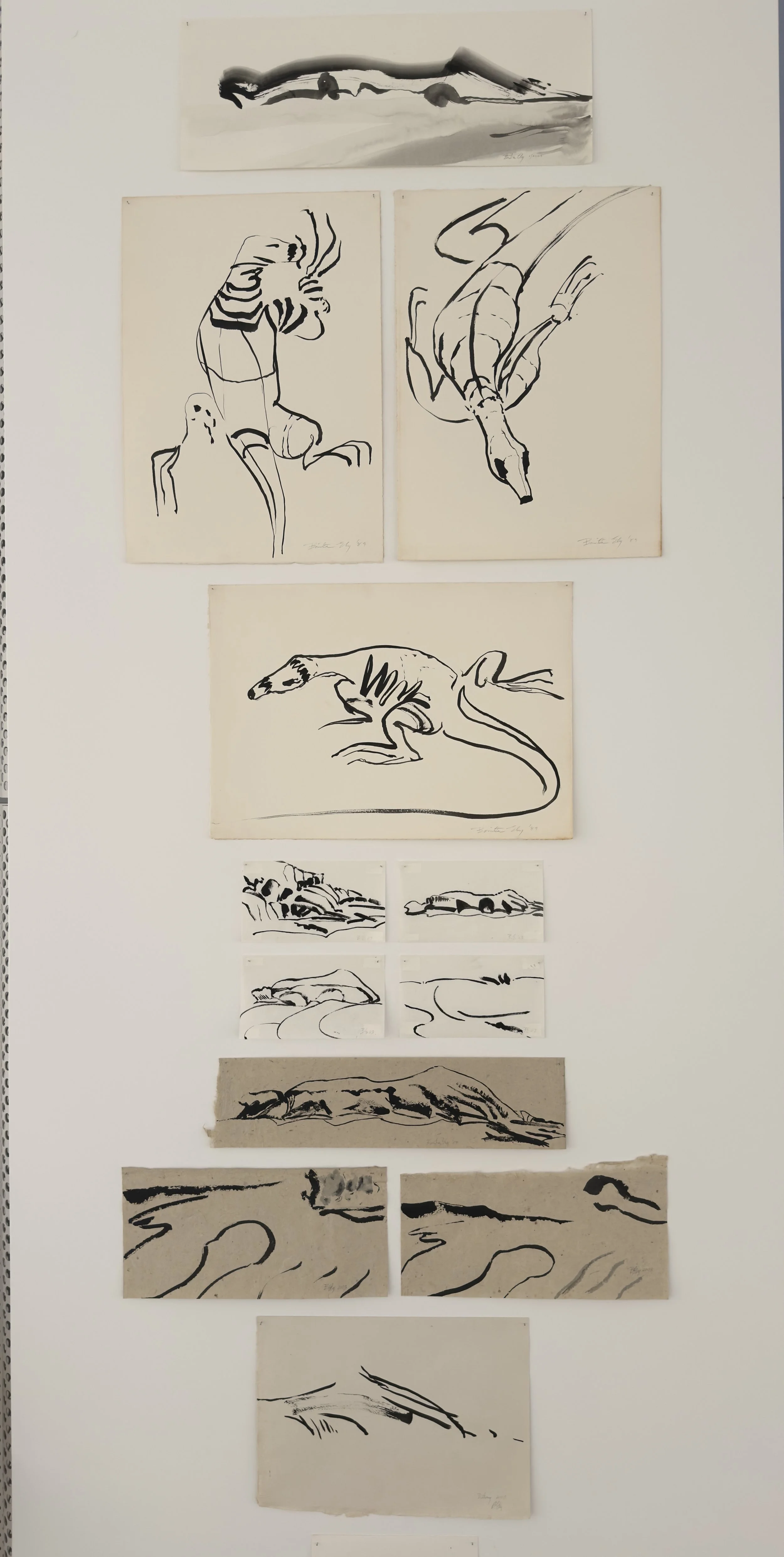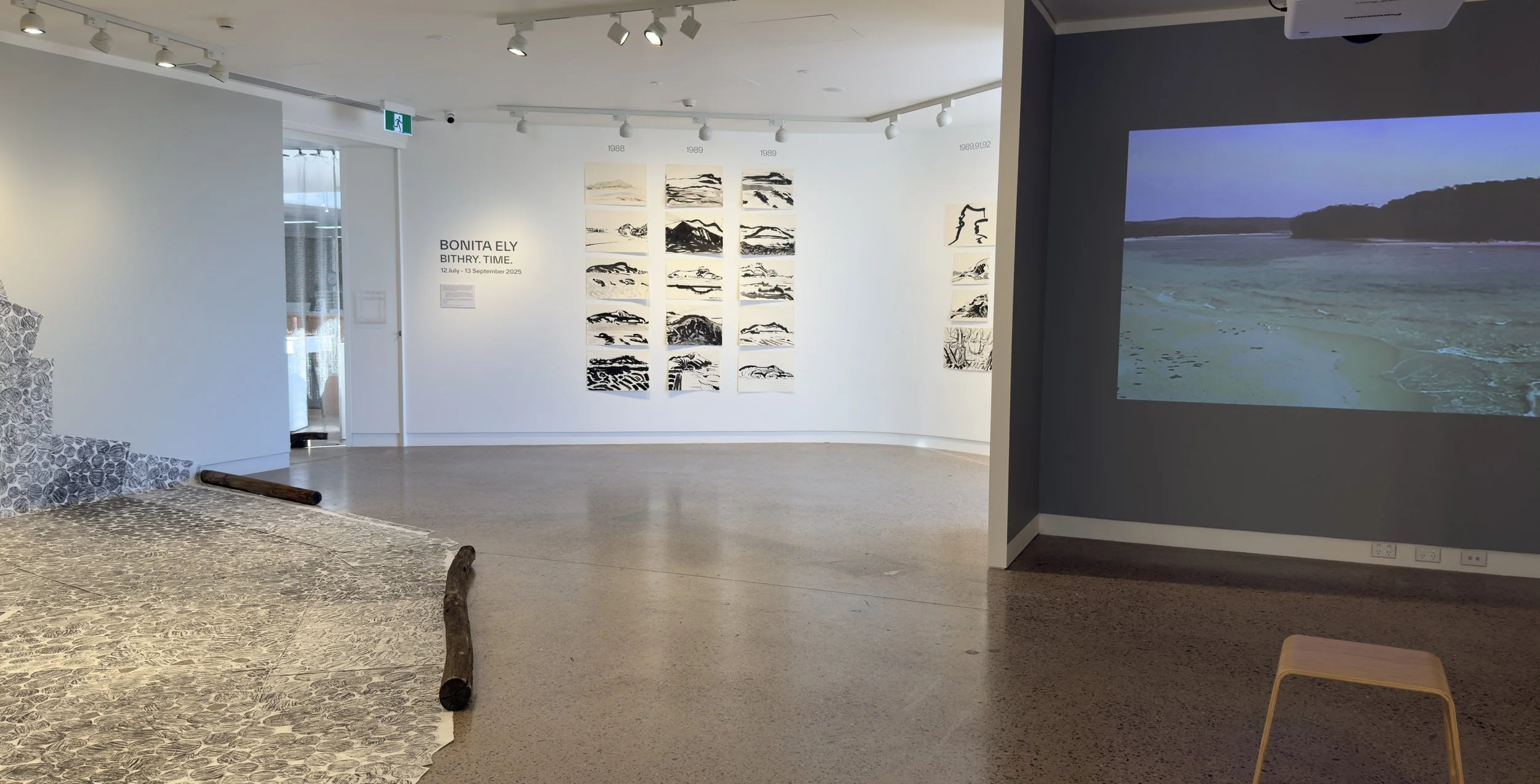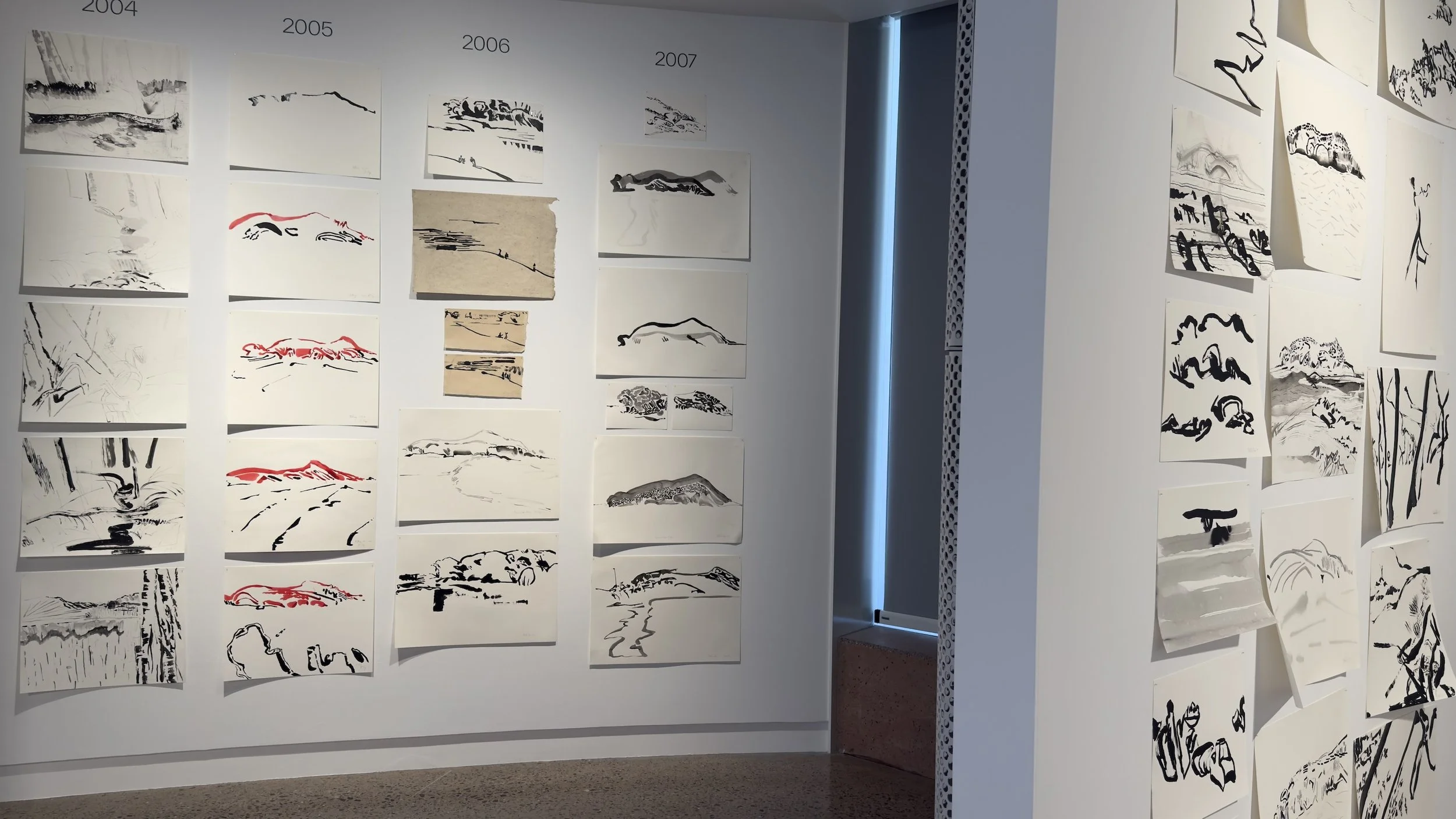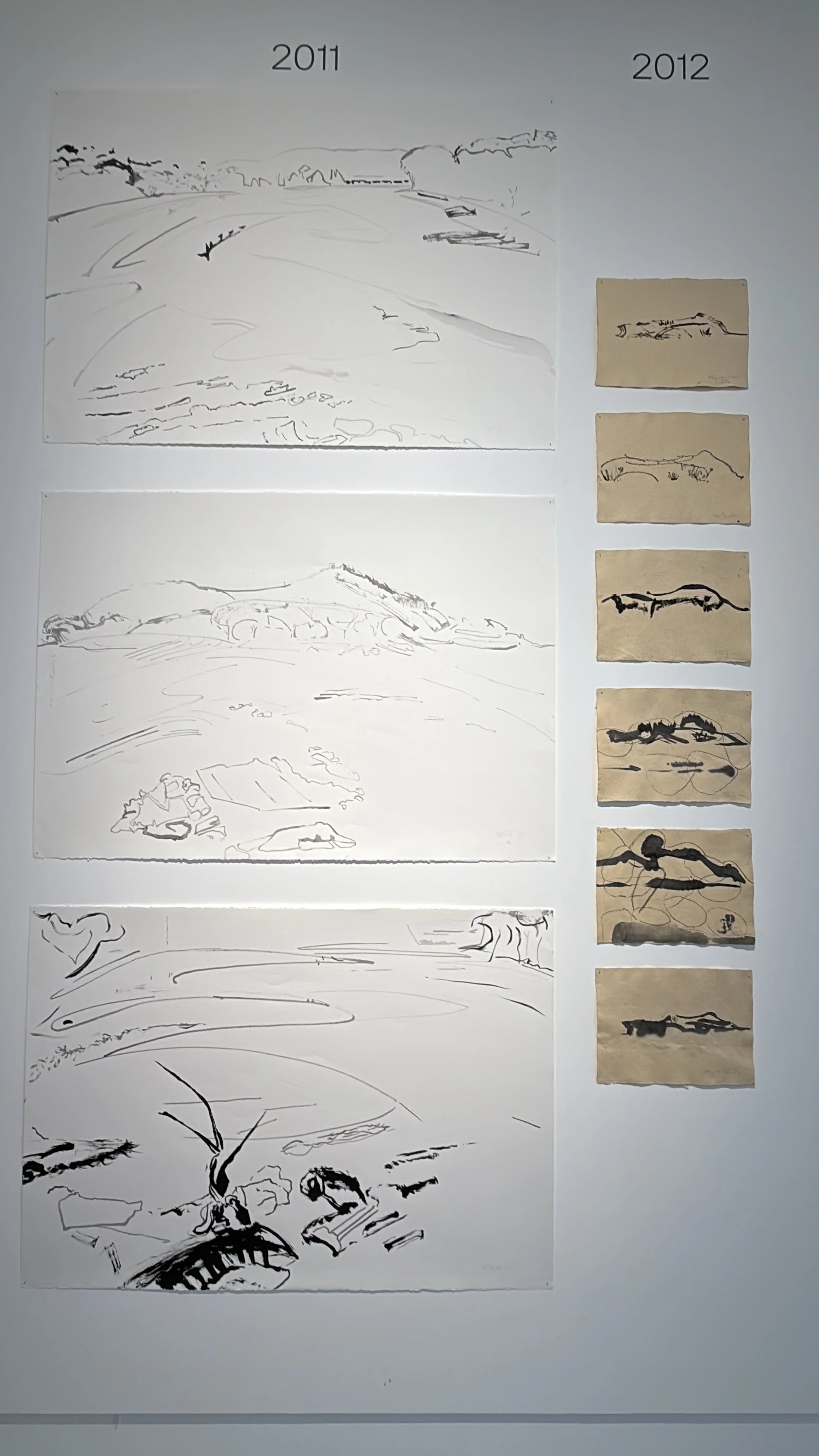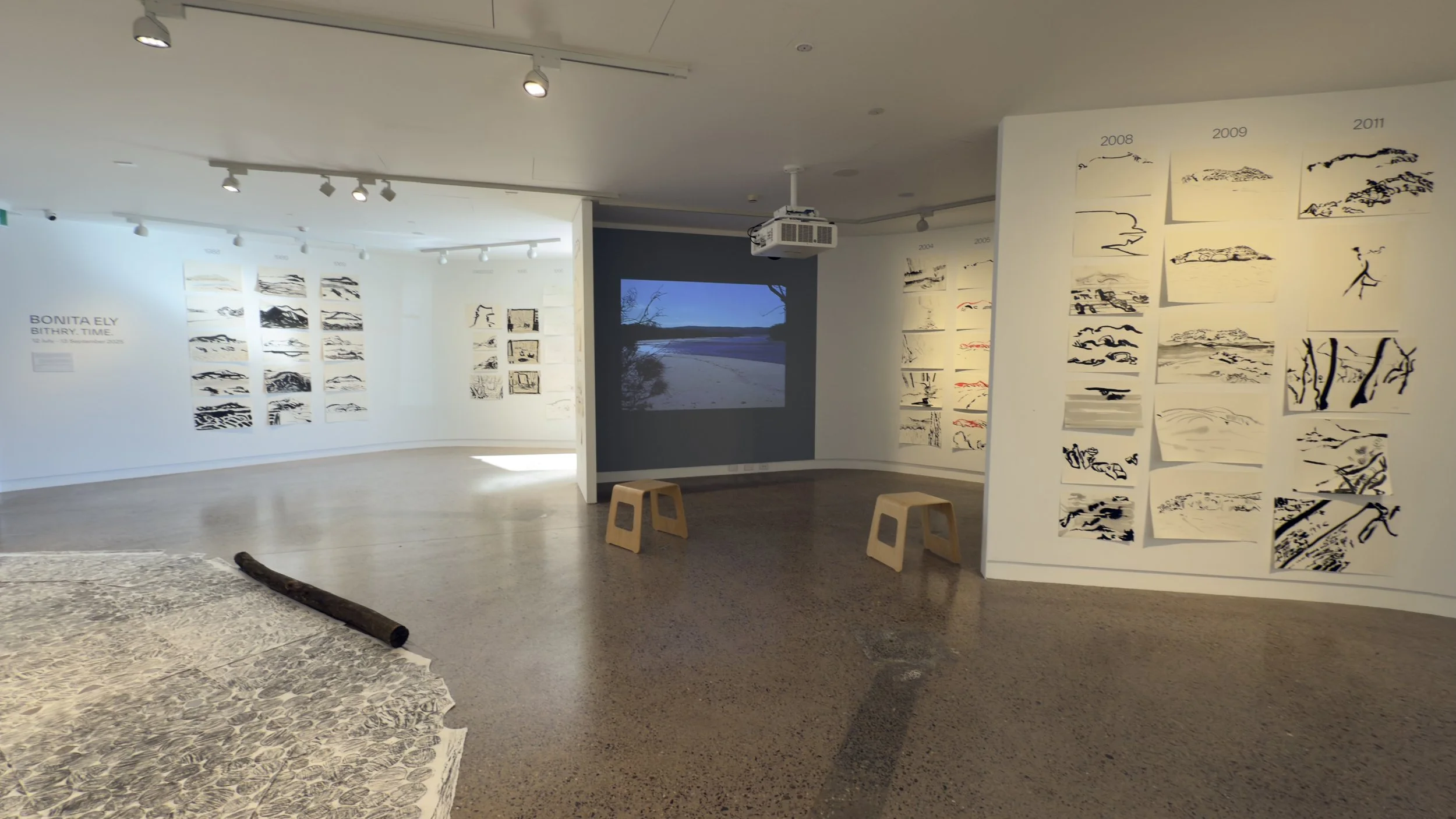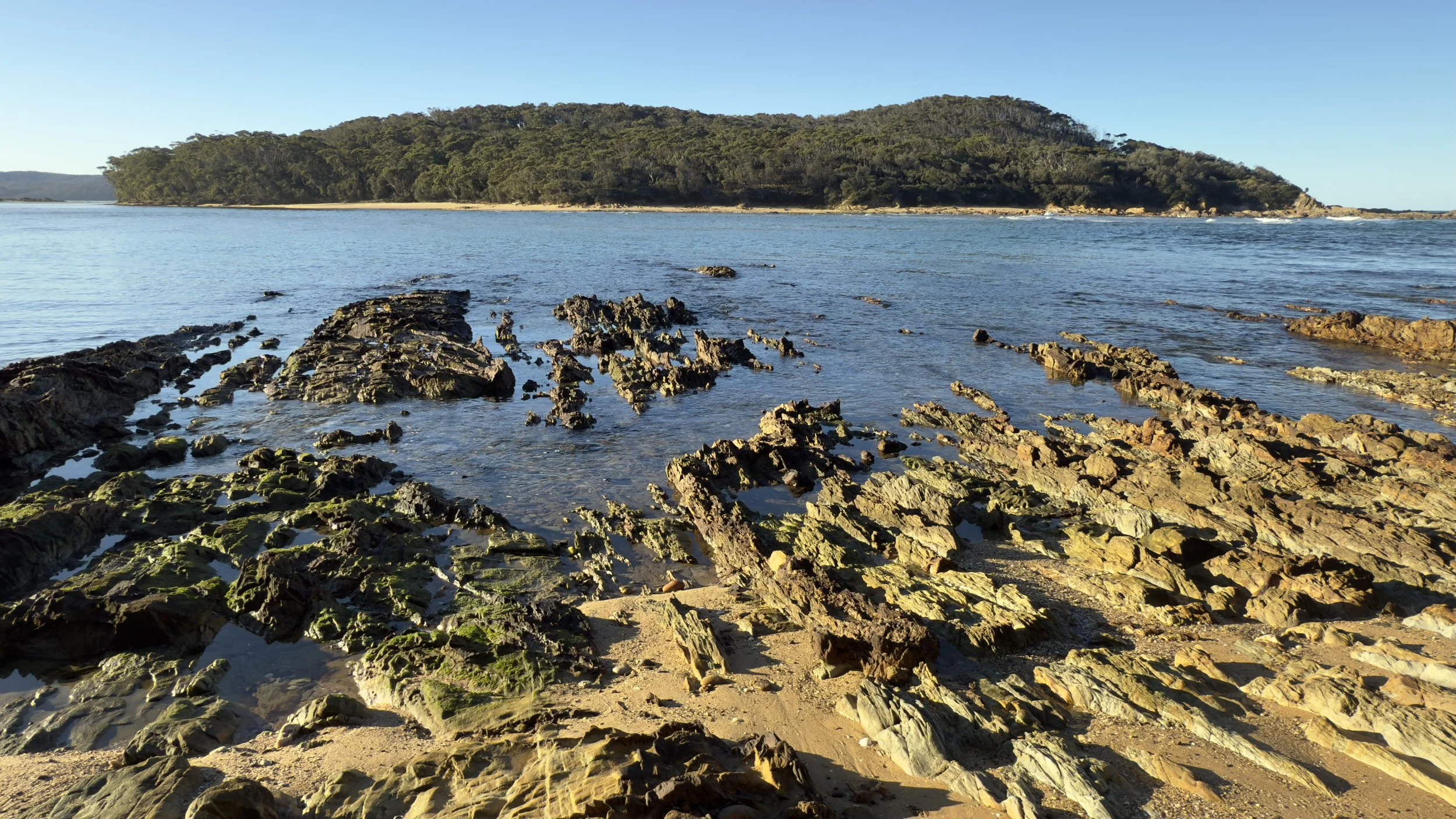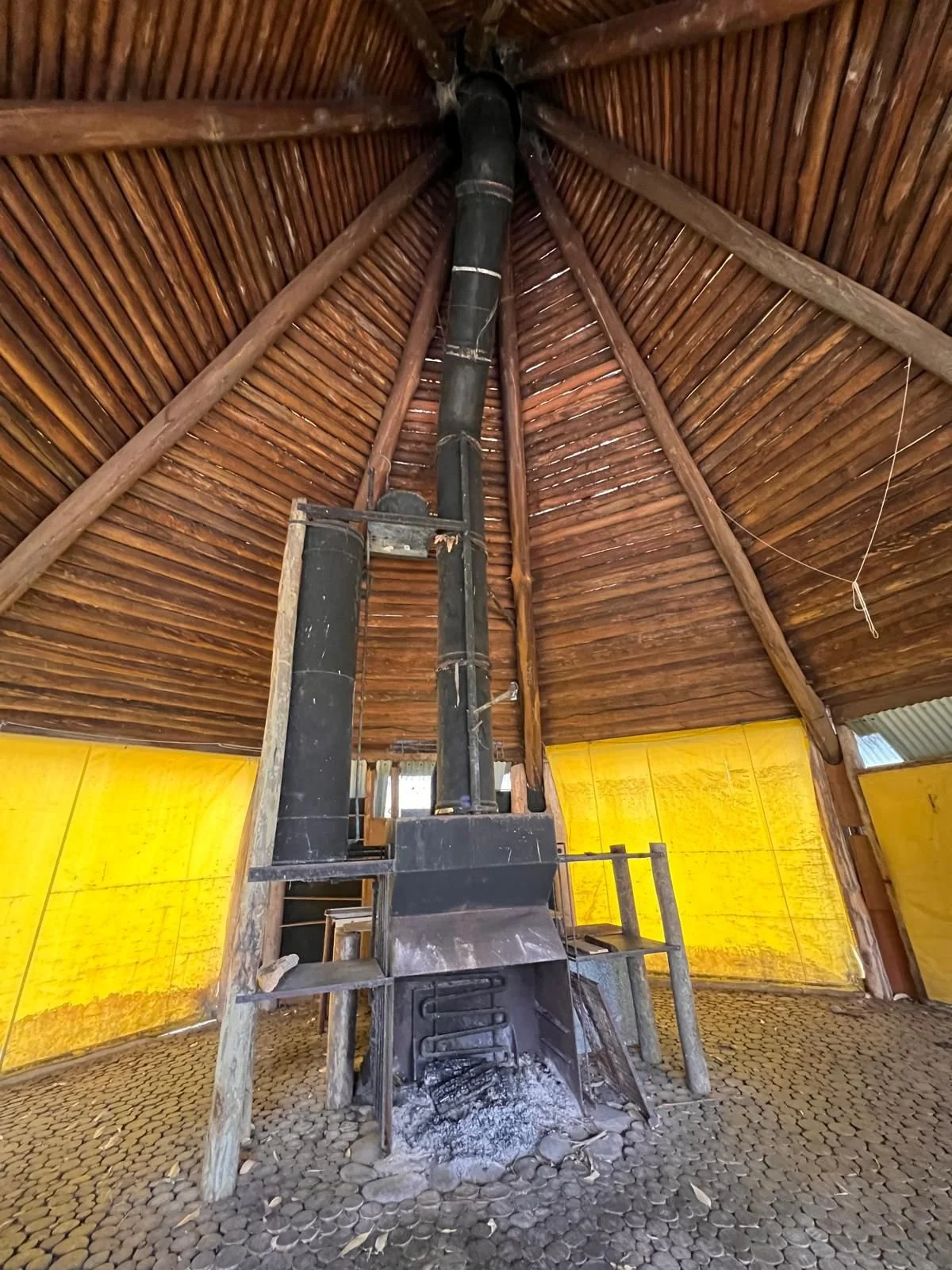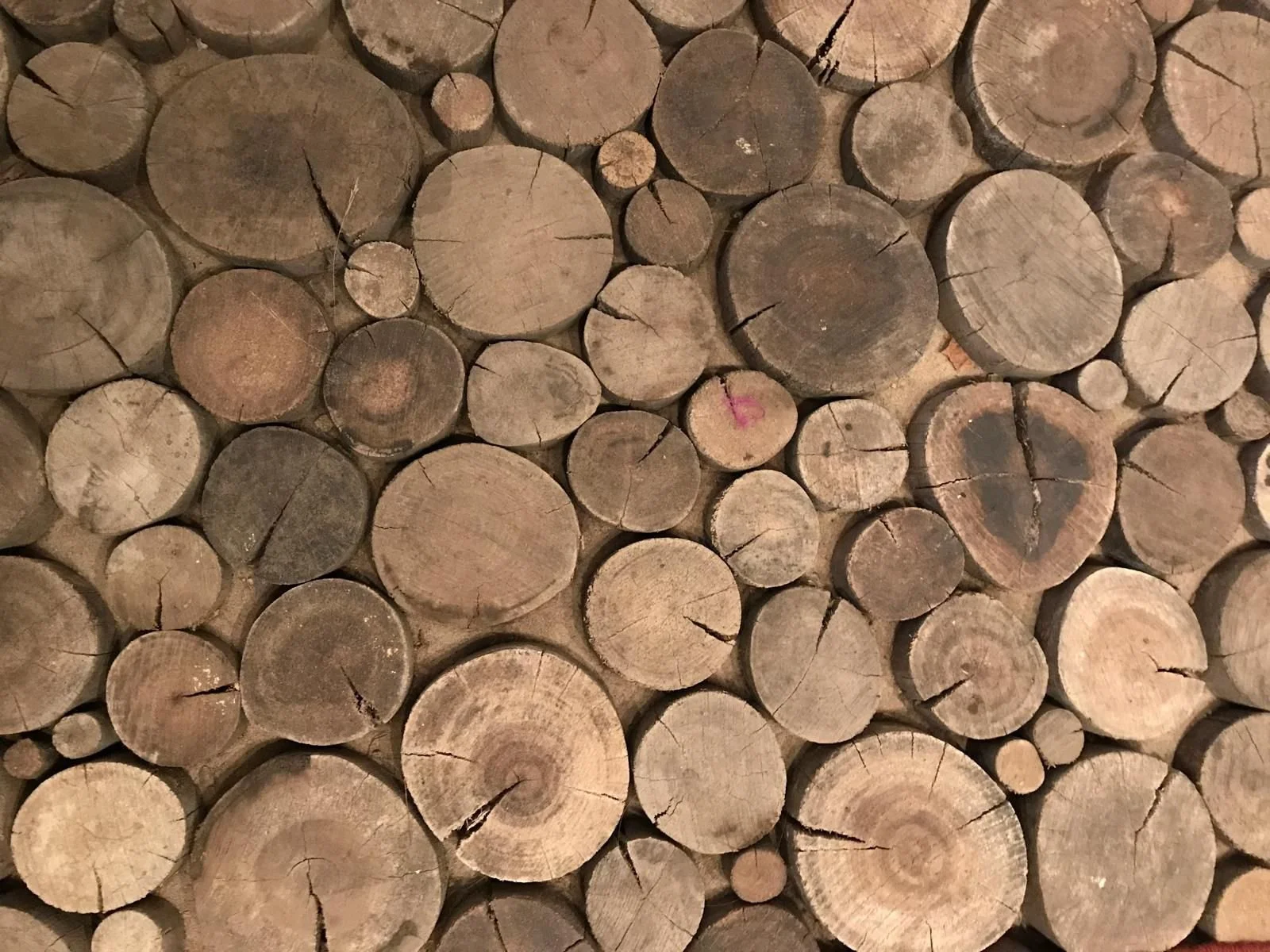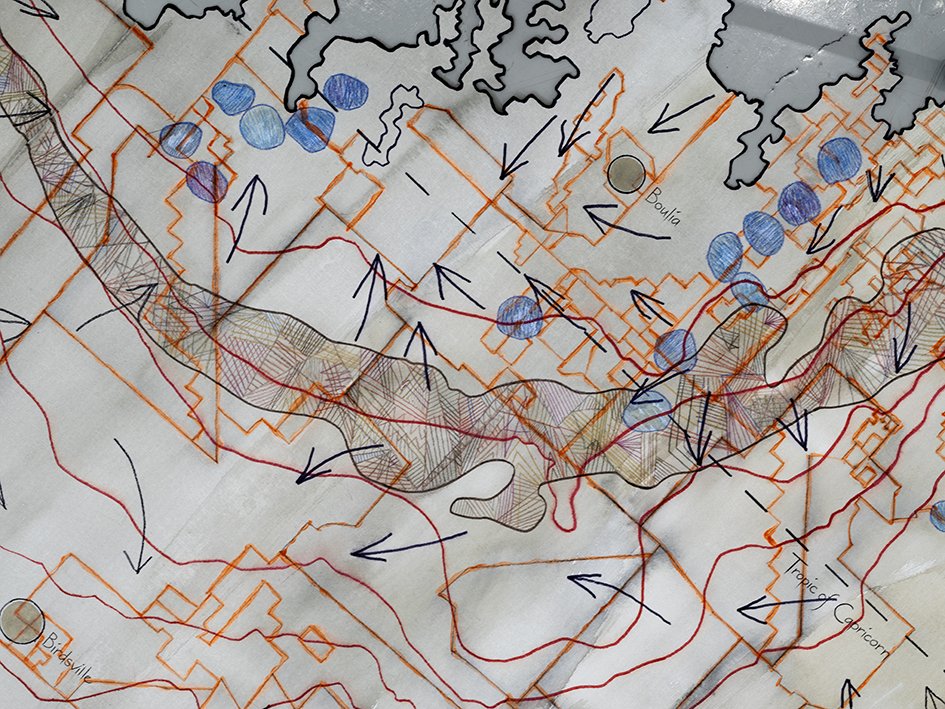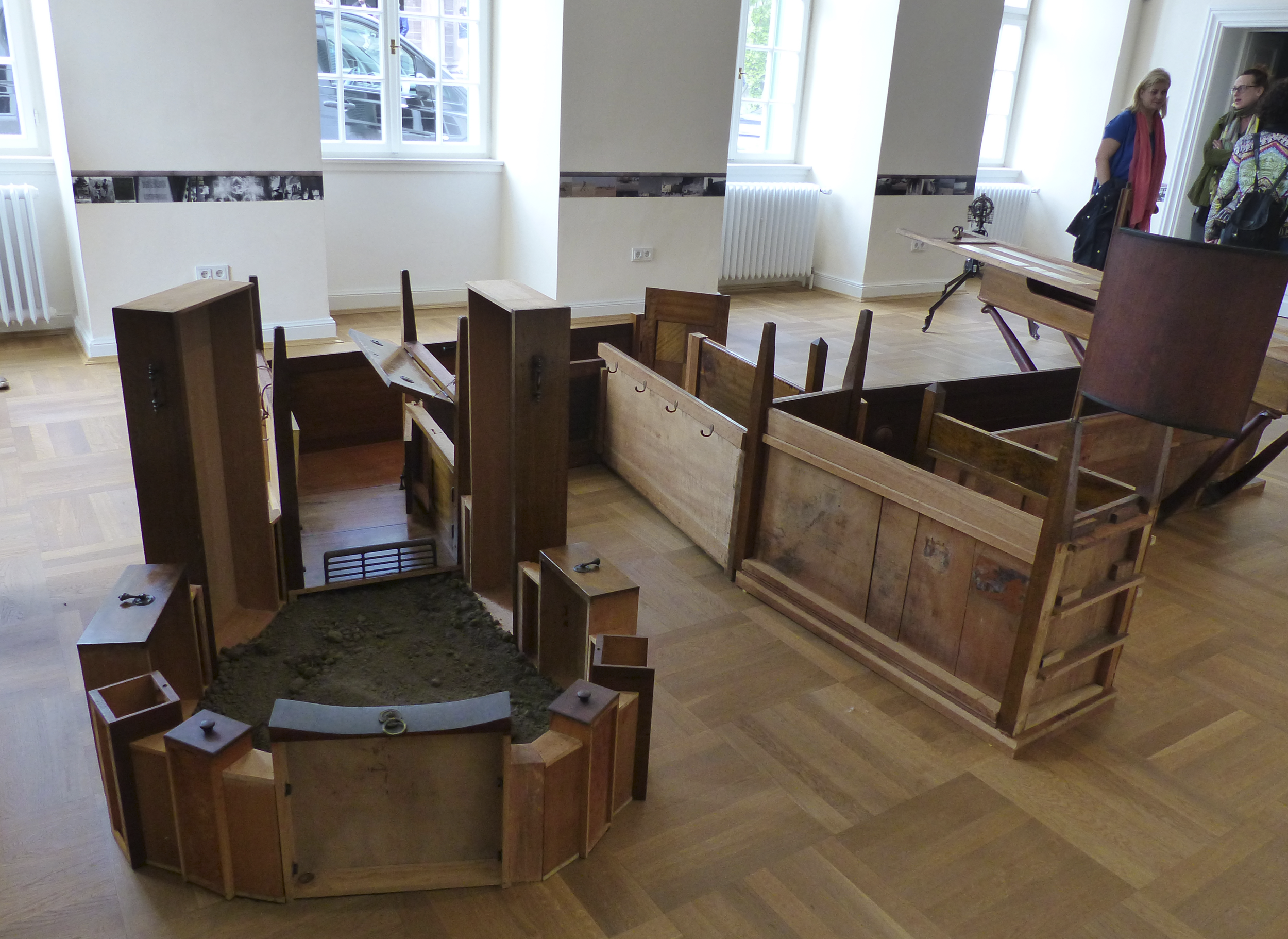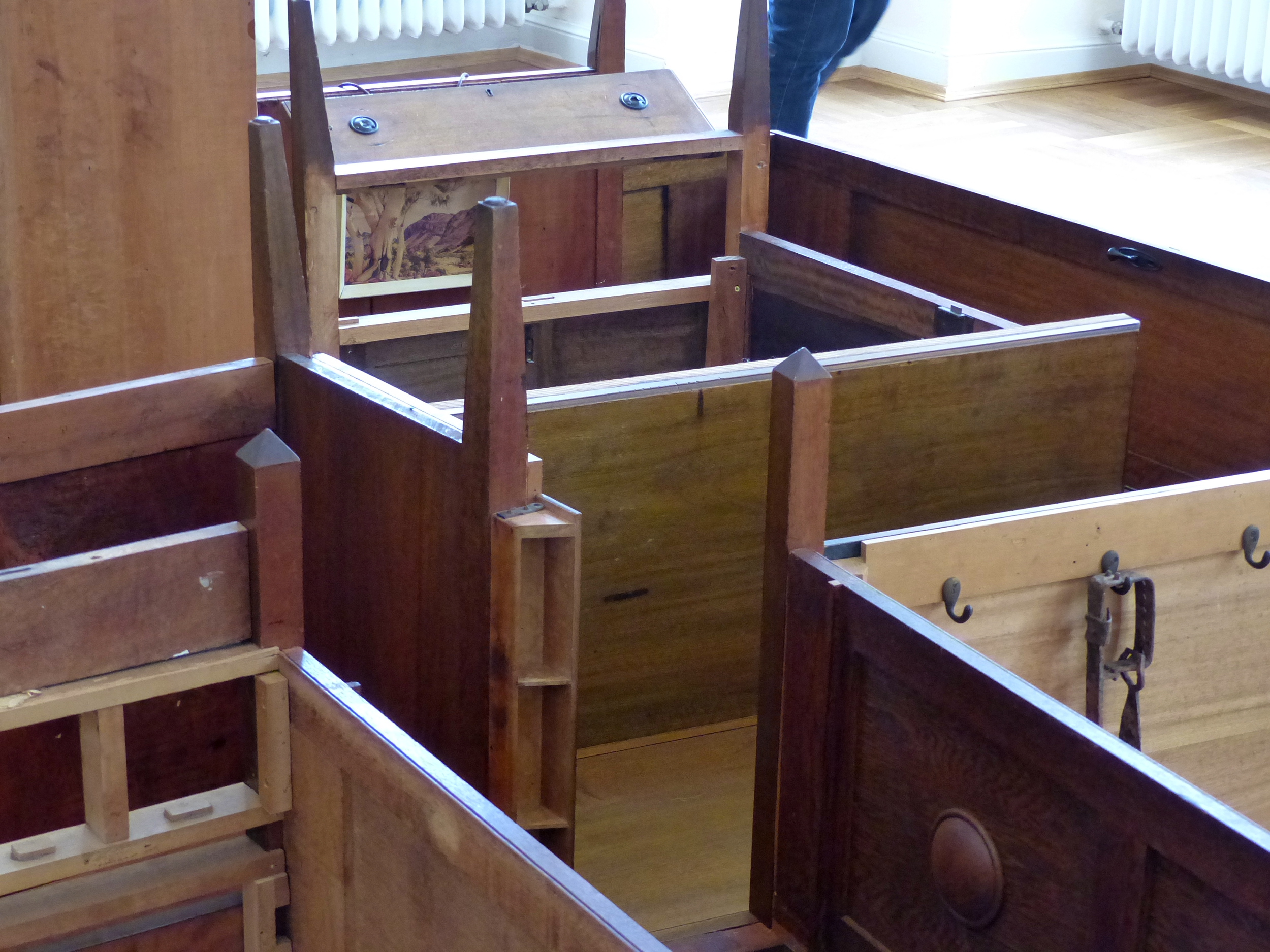Exhibition title: Bonita Ely Bithry. Time.
12th July - 13th September, 2025. South East Centre for Contemporary Art (SECCA), Bega, NSW.
A time based installation of 82 works on paper (1988 to 2012); the Barn Floor Rubbing (2012) made in collaboration with Marina Ely (2012); two videos of Bithry Inlet titled Dawn to Dusk Summer, and Dawn to Dusk, Winter (2004).
The installation on 7 walls of 82 works on paper installed in columns date from 1988 to 2012. Opposite to the ‘nooks’ containing the columns is the floor rubbing of the Barn, the family’s holiday home at Bithry Inlet, Tanja.
The Barn Floor Rubbing (2012). Marina Ely in collaboration with Bonita Ely. Installed on a long, curved wall opposite the works on paper. Black builders crayon on rice paper edged with three logs left over from the Barn, the family’s holiday home. Dimensions variable.
Detail, Barn Floor Rubbing: the gap in the rubbing - where the open fireplace backed onto a wood stove & the hot water tank that a possum lived on top of.
The Barn Floor Rubbing facing the works on paper.
THE WORKS ON PAPER - The entrance, walls 1 & 2, works from 1988 to 2001. RHS Wall 3.
Wall #2: Column 1, top, the shape of the estuary; bottom, coastal mahogany trees. Column 2, 1995, looking out of the Barn at the surrounding forest, ink on Vietnamese rice paper. Column 3, 1996, pencil, and pencil and pastel, on watercolour paper.. Column 4, 2001, High tide at Bithry Inlet.
Walls 1 & 2.
Wall 3: Goannas and Bithry Inlet, brush and ink on rice paper, dates variable.
The floor rubbing opposite time lapse videos combined with real time footage on wall 3, titled Bithry Inlet Summer Dawn to Dusk and Bithry Inlet Winter Dawn to Dusk.
Left: Wall 5. Column #1, 2004, the creek that runs into Bithry Inlet. Columns 2, 3, 4 - Bithry Inlet. RHS wall 6.
Walls 6 & 7, 2006 - 2012.
Wall 6. Column #1, 2008, bottom four, rocks. Column #2, 2009 dieback. Column #3, 2011, from top to bottom - dieback; log; coastal mahogany; beach with fisherman; rocks.
Wall 7, 2011, Left, the estuary, ink on watercolour paper; 2012, right, ink on Vietnamese rice paper.
Columns of works on paper & videos in ‘nooks’, opposite the long, horizontal rubbing.
***To view a selection of individual works on paper, go to Bithry Brush and Ink Seascapes***
BITHRY INLET AND THE BARN
Bithry Inlet, Mimosa Rocks National Park, Tanja, NSW.
The nonagon teepee-like holiday home designed by Sir Roy Grounds - blinds up in the Summer, blinds down in the Winter. RHS, 2 filled in spaces between the downward logs provided storage space, and a bathroom, toilet.
Interior of the Barn - its roof structure: small logs at the top rest on progressively bigger logs which are held in place, pressed between the corrugated iron roof and the nine long, sloping, vertical logs meeting in the centre, surrounding the chimney. On the floor, small stubs of wood (~10cm) are held vertically in sand. Water is heated by plumbing along the back of the open fireplace. The wood was treated in a wood preservation plant, a project experimenting with the tanalith wood preservation process to preserve eucalyptus, jointly established with Ken Myer.
https://en.wikipedia.org/wiki/Penders_(holiday_retreat)
Detail: the barn floor.
ARTISTS STATEMENT Open to the elements in a coastal Mahogany (Eucalyptus botryoids) enclave fringed by spotted gums (Corymbia maculata), visited by creatures, my daughter Marina and I spent ideal holidays exploring the bush, the estuary, coastline: swimming, rock hopping, fireplace cooking, star gazing - Bithry Inlet, now in Mimosa Rocks National Park. Beginning in 1982, we holidayed there. Our holiday home, the Barn overlooking Bithry Inlet, is a nonagon shaped teepee-like structure experimentally designed by Marina’s grandfather, Roy Grounds. This would now be described as ‘clamping’. For me it was also a ‘busman’s holiday’. With watercolour paper, ink, Chinese brushes and my video camera overlooking Bithry Inlet, I rapidly captured the ever-changing light, movement, tides, reflections, including the Millennium Drought dieback - the seascape moment to moment. In essence - time-based art.
For the sage, Ching Hao, the aim of painting is not a matter of representing forms:
... but of capturing Reality or Truth, and the Reality is only brought into painting when the artist in the process of painting is mystically unified with the Cosmic act of Creation. Through this process, the artist can create in [her/his] painting a true microcosm which is filled with ch’i [life force, or vital force] ...
Ref/ Ching Hao’s Pi-fa-chi: A Note on the Art of Brush. Artibus Asiae Supplementum. Vol. 31. Pp 1 -56.
Marina and I adore observing nature. We have eagle eyes - minuscule investigations, nature’s infinite beauty, inter-connectedness, evolution. Like her father she has a gentle affinity with animals – they come to Marina, unafraid. In 2011 our private lease concluded in accordance with Roy Grounds’ donation to the NPWS. Marina suggested we commemorate the memories held by place by making a rubbing of the Barn’s floor, its pattern of off-cuts from Roy’s timber preservation mill. A nine-sided floor-based artwork is the result, a section of which adorns the exhibition.
Let Me Take You There: the Great Artesian Basin
Let Me Take You There: the Great Artesian Basin - GAB floor map, 2021 Showing the aquifer’s contours (metres), ground water flow, springs; gas & petroleum exploration or production sites; recharge zones, cities & towns for orientation; Tropic of Capricorn; Gulf of Carpentaria.
Scale: 5000mm X 4140mm Mixed media – primed canvas, water colour, pencil, ink, crayon, acrylic paint, felt tip pen.
Map’s legend.
Detail showing recharge zones, springs, ground water flow, gas & petroleum exploration or production sites, Tropic of Capricorn, contours.
We only map locations and resources that are of use to us … my long fascination with maps has taken me to the Great Artesian Basin (GAB), a result of my field research in Central Queensland documenting the natural environments in the region of the Adani, ergo Carmichael, ergo Bravus thermal coal mine, which I then discovered is located above the GAB. Concerns that this pure underground water will be polluted by coal mining added to my initial concerns - environmental decline, carbon emissions and global warming.
The GAB is the biggest aquafer in the world, underlying around one fifth of Australia. It is a source of water from the tip of Queensland down to New South Wales, across into the Northern Territory and into South Australia. Our agriculture and livestock industries largely depend upon it.
On the field I discovered Queensland’s central and northern environments are dictated by alternating Dry Seasons in the winter when rivers dry up, followed by Wet Seasons’ massive floods in the summer. Coal mining will potentially over-extract water in Dry Seasons and pollute with coal dust the GAB’s precious water in the Wet Seasons.
Yet like myself at the time, few people are aware of the Great Artesian Basin.
Central to the installation, Let Me Take You There: the Great Artesian Basin is a desire to reveal this unique, hidden natural habitat and its precious water.
We must protect it for the future.
Great Artesian Basin artworks and installations, Milani Gallery, Brisbane, 2022
Great Artesian Basin map installed on the floor, with its Legend displayed on the wall, Milani Gallery Queensland. Also exhibited in the Penrith Regional Gallery, Sydney, 2022/23, in the group exhibition, ‘Undercurrents’.
The Dancers, 2022, Felt, silk, charcoal, paper, bone, plywood.
In my imagination the Great Artesian Basin map resembles a Spanish dancer - dressed in black with ragged grey veils, jewellery made of coal, one has hair made of tabs with random trivia from incontinence pads’ packaging; text on litter found on Marrickville streets reflecting our zeitgeist - ie/ rampant consumerism, bureaucratic, controlling gobble-de-gook, anonymous very personal information; one is bandaged with fabric scraps.
They are brides in mourning.
Left: soft black felt with a ragged grey veil; a coal tiara and coal belt. Right: soft black felt stretched over a plywood shape, roughly bandaged with torn scraps of black and grey silk cloth.
Left: A plywood shape covered in litter off city streets, the text reflecting our zeitgeist, culture, economy, bureaucratic blather, the intrapersonal. Right: A plywood shape covered in soft black felt with a torn silk veil concealing the skeleton of a hand; a coal tiara.
Soft black felt, stretched onto plywood, shaped an abstraction of the GAB map; ragged grey veil; charcoal tiara.
Soft black felt stretched onto plywood shaped an abstraction of the GAB map; charcoal belt; strips of paper squares from incontinence pads’ wrapping joined together like hair. The strips of paper are printed with ‘different, unusual’ trivia such as: “ODD SPOT #165: A camel can shut its nostrils in a dust storm”; “ODD SPOT #214: Most people find it impossible to lick their own elbow”; “ODD SPOT #399: In 1946, a team of six incredible women programmed the first digital computer; “ODD SPOT #97: Bees fly an average of 15 miles per hour”; ODD SPOT #7: Pearls melt in vinegar; ODD SPOT #17: Hawaii is moving towards Japan 4 inches every year.
Might this random information provide a distraction from the annoyance of incontinence as well as break the taboo?
Road Trip video, 2022
Flat screen installed with the floor map of images, text and sound from field trips during the Dry Season when rivers dry up, and the Wet Season when rivers flood, researching the natural environments in the vicinity of the Adani coal mine.
Plastikus Progressus
documenta 14, Athens School of Fine Arts Gallery, 8 April - 16 July 2017


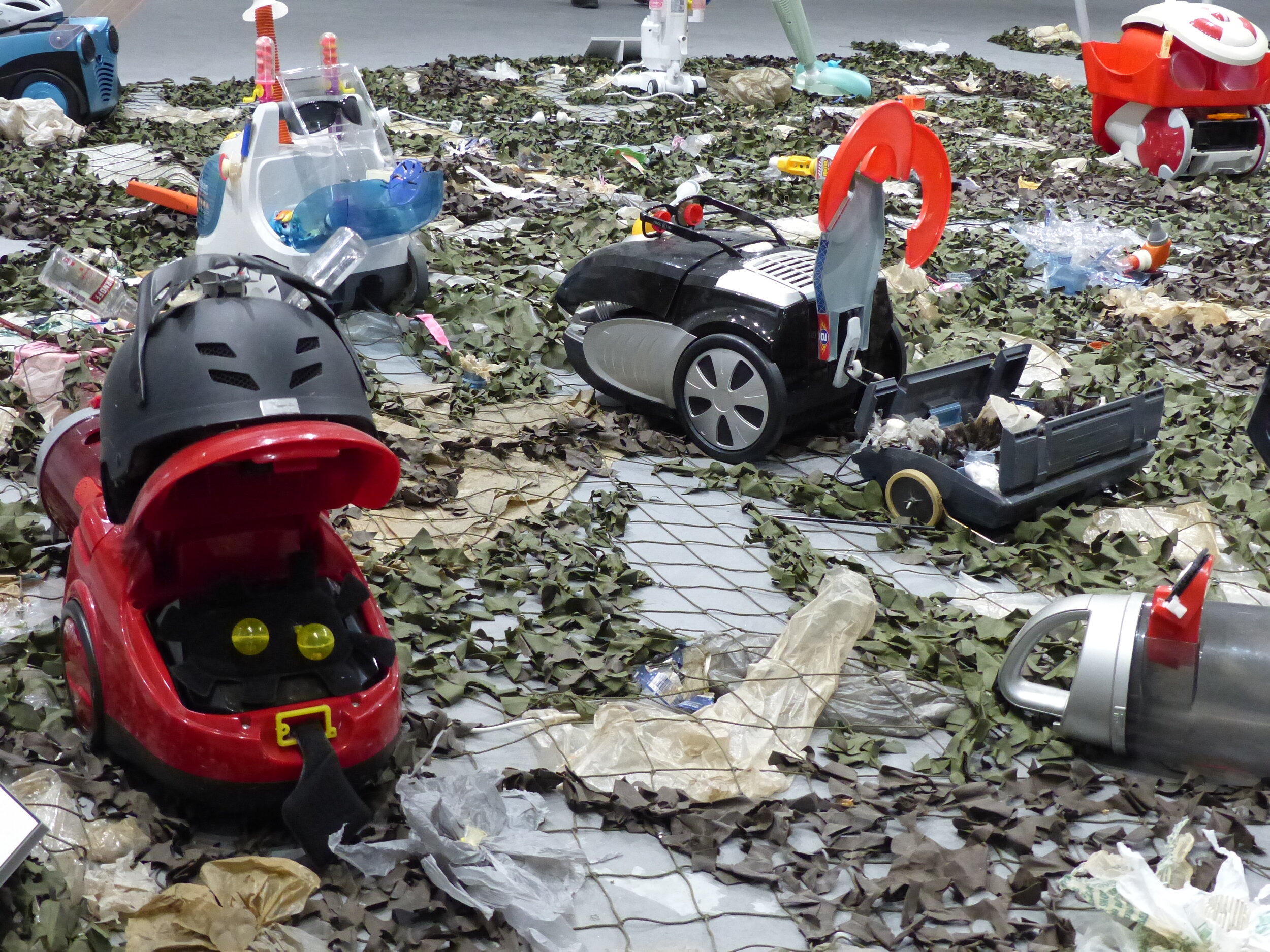
Interior Decoration
documenta 14, Palais Bellevue, Kassel, Germany, 8 Apr - 17 Sep 2017
The sculptures are constructed from my parent’s bedroom furniture comprising a trench and watchtower, and a Vickers machine gun made from my mother’s Singer sewing machine and bobby pins. The convolution of the domestic and feminine with the military creates uncanny feelings, the Trench sensations of a return to childhood. The dado around the walls is composed of images of war and trauma, with the names of Jewish people engraved on the railway track by artist, Dr. Horst Hoheisel. His installation is titled, Das Gedächtnis der Gleise (The Memory of the Tracks), at KulturBahnhof (Kassel Central Station). Kassel’s Jewish people were deported by train from Kassel to Majdanek, Sobibor, Theresienstadt and the ghetto of Riga - no one survived.
Watchtower with Sewing Machine Gun, Documenta 14, Kassel, Germany. Watchtower is constructed from a double bed; Sewing machine Gun, constructed with bobby pins and my mother’s Singer Sewing Machine.
A second gun across the Trench with photographs of Israeli watchtowers, documented during field work following my father’s 2WW tour of duty (2nd/1st Machine Gun Battalion) through what was Palestine to Syria to fight the Vichy French.
Singer Sewing Machine commissioned by the Australian War Memorial, Canberra, for the exhibition, After the War, 2019.
